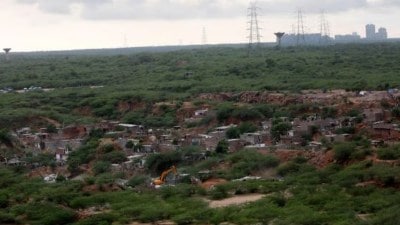Lake levels nearing 100% capacity; water cut unlikely till next monsoon
BMC said that a good bout of monsoon spell in September was crucial for the 7 lakes which supply water to Mumbai city to touch their full capacity, failing which water cut throughout the next year was on the cards.
 A woman and child brave the rain in Mumbai. (Express Photo by Ganesh Shirsekar)
A woman and child brave the rain in Mumbai. (Express Photo by Ganesh Shirsekar) The water stock in the seven lakes which supply water to Mumbai touched 99.6 percent on Wednesday, which amounts to 14.42 lakh million litres, showed the Brihanmumbai Municipal Corporation’s (BMC) data. This comes as the city is likely to receive more rains amid a yellow alert in Mumbai and neighbouring districts.
This is the highest water level in the lakes in the past three-years, indicating that there will likely be no water cut in the city till next monsoon.
The civic data shows that earlier on September 27, 2022, the water stock in the seven lakes stood at 98 percent, while in 2021 the stock was 99.09 percent.
Mumbai draws its water from seven lakes – Tulsi, Vehar, Modak Sagar, Upper Vaitarna, Middle Vaitarna, Tansa and Bhatsa. The catchment areas of these lakes get filled during monsoon every year and if the water level doesn’t reach a satisfactory level, the civic body implements a water cut.
According to Brihanmumbai Municipal Corporation (BMC) officials, the lake levels can never touch 100 per cent of its capacity owing to the fact that the water in the lakes is drawn to meet the megalopolis’ daily water requirement.
With the city experiencing a dry spell throughout August, Brihanmumbai Municipal Corporation (BMC) officials said that a good bout of monsoon spell in September was crucial for the lakes to touch their full capacity, failing which, the civic body was planning to introduce a water cut throughout the next year.
The country’s financial capital is dependent on monsoon showers for its annual water supply with Mumbai drawing its daily water supply from seven lakes — Tansa, Bhatsa, Modak Sagar, Tulsi, Vehar, Upper Vaitarna and Middle Vaitarna — situated in the city’s suburbs and its neighbouring districts.
The catchment areas of these lakes get filled during monsoon, following which water is supplied to the city via a network of pipelines.
The rise in the lake level has allayed the fears of the civic body.
P. Velrasu, additional municipal commissioner (Projects), said that every one percent indicates an available water stock for three days.
“Water cut in Mumbai is unlikely till next monsoon as the lake levels have reached their maximum capacity. Last year, the lake levels were above 95 percent during the last week of September. As a result no significant water cut was imposed till this year. We only imposed a cut as a precautionary measure as the monsoon arrival got delayed. This year, we had good rainfall, so the chance of imposing any new cut would be minimal,” Velrasu said.
Furthermore, according to senior civic officials from the hydraulic department, the lakes when filled to maximum capacity can provide the city its daily supply of water until at least June 15 next year.
Following a dry August, Mumbai in September has surpassed its monthly quota of rain this year. Data procured from India Meterological Department (IMD) shows that while the city recorded 387 mm of rain till Monday morning, the monthly average for the month of September is 359 mm.
Meanwhile, the IMD has sounded a yellow alert in Mumbai, Thane, Palghar and Raigad until Thursday at least, indicating the possibility of thunderstorms coupled with lightning and gusty winds.







